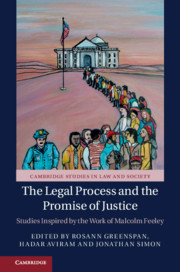Book contents
- The Legal Process and the Promise of Justice
- Cambridge Studies in Law and Society
- The Legal Process and the Promise of Justice
- Copyright page
- Contents
- About the Contributors
- Introduction: Past as Prologue
- Part I The Process Is the Punishment
- Part II Court Reform on Trial
- 5 Regulating E-Cigarettes: Why Policies Diverge
- 6 Japanese Court Reform on Trial
- 7 Court Reform and Comparative Criminal Justice
- 8 The Birth of the Penal Organization: Why Prisons Were Born to Fail
- 9 The Misbegotten: Infanticide in Victorian England
- Part III Judicial Policymaking and the Modern State
- Part IV Political Liberalism and the Legal Complex
- Index
- Books in the Series
- References
9 - The Misbegotten: Infanticide in Victorian England
from Part II - Court Reform on Trial
Published online by Cambridge University Press: 18 April 2019
- The Legal Process and the Promise of Justice
- Cambridge Studies in Law and Society
- The Legal Process and the Promise of Justice
- Copyright page
- Contents
- About the Contributors
- Introduction: Past as Prologue
- Part I The Process Is the Punishment
- Part II Court Reform on Trial
- 5 Regulating E-Cigarettes: Why Policies Diverge
- 6 Japanese Court Reform on Trial
- 7 Court Reform and Comparative Criminal Justice
- 8 The Birth of the Penal Organization: Why Prisons Were Born to Fail
- 9 The Misbegotten: Infanticide in Victorian England
- Part III Judicial Policymaking and the Modern State
- Part IV Political Liberalism and the Legal Complex
- Index
- Books in the Series
- References
Summary
In February 1829, Harriet Farrell, aged seventeen, found herself on trial in the Old Bailey (the central criminal court of London), charged with “the willful murder of her bastard child.” Harriet was a servant, in the household of Jonathan Cook, a “trunk-maker.” Cook’s wife had asked her repeatedly if she was in the “family way”; but Harriet had always denied it. She denied giving birth, too; but the Cooks were suspicious, and they found the body of a baby in the privy. At this point, Harriet ended up in the hands of the law, charged with murder. But when she was tried in the Old Bailey, the jury returned a verdict of not guilty. They did find Harriet guilty of a lesser crime, concealing the birth of a child, and she was sentenced to a year in prison.
- Type
- Chapter
- Information
- The Legal Process and the Promise of JusticeStudies Inspired by the Work of Malcolm Feeley, pp. 172 - 190Publisher: Cambridge University PressPrint publication year: 2019

